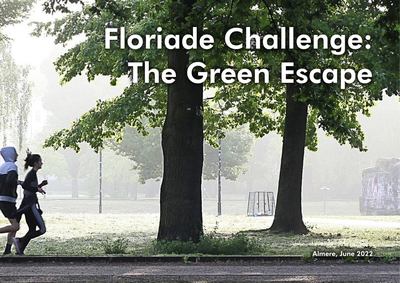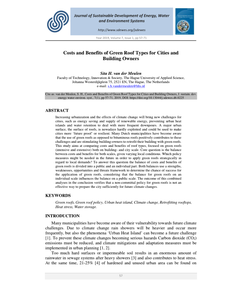Almere is a green city where the greenery extends into the centre through a framework of nature, forests, parks and canals. With this green environment, Almere fulfils an important condition for a liveable city, where it is pleasant to live and work. An important goal for the municipality is to challenge its residents to develop a healthy lifestyle by using that green framework.But what really motivates Almeerders to go outside to exercise, enjoy the surroundings and meet each other? Are there sufficient green meeting or sports facilities nearby? Could the routes that connect the living and working environment with the larger parks or forests be better designed? And can those routes simultaneously contribute to climate adaptation?With the Green Escape Challenge, we invited students and young professionals to work on these assignments together.
DOCUMENT

Computers create environmental problems. Their production requires electricity, raw materials, chemical materials and large amounts of water, and supplies (often toxic) waste. They poison dumping sites and pollute groundwater. In addition, the energy consumption in IT is growing exponentially, with and without the use of ‘green’ energy. Increasing environmental awareness within information science has led to discussions on sustainable development. ‘Green Computing’ has been introduced: the study and practice of environmentally sustainable computing or IT. It is necessary to pay attention to the value of the information stored. In this paper, we explored the possibilities of combining Green Computing components with two theories of archival science (Archival Retention Levels and Information Value Chain respectively) to curb unnecessary power consumption. Because in 2012 storage networks were responsible for almost 30 % of total IT energy costs, reducing the amount of stored information by the disposal of unneeded information should have a direct effect on IT energy use. Based on a theoretical analysis and qualitative interviews with an expert group, we developed a ‘Green Archiving’ model, that could be used by organizations to 1] reduce the amount of stored information, and 2] reduce IT power consumption. We used two exploratory case studies to research the viability of this model.
MULTIFILE

Green Urban Solutions is de overkoepelende benaming voor innovatieve toepassingen van groen in stedelijk gebied, zoals bijvoorbeeld groene daken, groene gevels, indoor groen en specifiek ontworpen aanplant op pleinen en perken. Ondanks de vele waarden die Green Urban Solutions genereren en het brede scala aan stakeholders die hier belang bij hebben, ontbreekt het tot nog toe aan solide business modellen voor Green Urban Solutions waarin deze stakeholders gekoppeld worden aan de verschillende waarden die ze genereren. Het doel van dit onderzoek is om drie nieuwe business modellen te ontwikkelen en een advies te geven voor het betrekken van stakeholders om deze modellen te versterken en te verwezenlijken. Hiervoor is de volgende hoofdvraag opgesteld: ‘’Wat is het Nederlandse business model voor Green Urban Solutions dat de schakel vormt met de stakeholders waar ze waarde voor creëert?’’.
DOCUMENT

In Europe, green hydrogen and biogas/green gas are considered important renewable energy carriers, besides renewable electricity and heat. Still, incentives proceed slowly, and the feasibility of local green gas is questioned. A supply chain of decentralised green hydrogen production from locally generated electricity (PV or wind) and decentralised green gas production from locally collected biomass and biological power-to-methane technology was analysed and compared to a green hydrogen scenario. We developed a novel method for assessing local options. Meeting the heating demand of households was constrained by the current EU law (RED II) to reduce greenhouse gas (GHG) emissions by 80% relative to fossil (natural) gas. Levelised cost of energy (LCOE) analyses at 80% GHG emission savings indicate that locally produced green gas (LCOE = 24.0 €ct kWh−1) is more attractive for individual citizens than locally produced green hydrogen (LCOE = 43.5 €ct kWh−1). In case higher GHG emission savings are desired, both LCOEs go up. Data indicate an apparent mismatch between heat demand in winter and PV electricity generation in summer. Besides, at the current state of technology, local onshore wind turbines have less GHG emissions than PV panels. Wind turbines may therefore have advantages over PV fields despite the various concerns in society. Our study confirms that biomass availability in a dedicated region is a challenge.
DOCUMENT

In order to gain a more mature share in the future energy supply, green gas supply chains face some interesting challenges. In this thesis green gas supply chains, based on codigestion of cow manure and maize, are considered. The produced biogas is upgraded to natural gas quality and injected into the existing distribution gas grid and thus replacing natural gas. Literature research showed that relatively much attention has been paid up to now to elements of such supply chains. Research into digestion technology, agricultural aspects of (energy) crops and logistics of biomass are examples of this. This knowledge is indispensable, but how this knowledge should be combined to help understand how future green gas systems may look like, remains a white spot in the current knowledge. This thesis is an effort to fill this gap. A practical but sound way of modeling green gassupply chains was developed, taking costs and sustainability criteria into account. The way such supply chains can deal with season dependent gas demand was also investigated. This research was further expanded into a geographical model to simulate several degrees of natural gas replacement by green gas. Finally, ways to optimize green gas supply chains in terms of energy efficiency and greenhouse gas reduction were explored.
DOCUMENT

Green spaces play an important role in urban areas. We study the accessibility of green urban areas by combining open data sets about green with population size data. We develop a mathematical model to define the population density of a green area and calculate the available green space depending on the location. To this end, we do not only consider walking distance to and size of the green area, but also take into account the local population size. Our model quantifies how the available green space depends on the location in the city, such that heavily populated areas have a small amount of green available, even when closely located to a green area.
DOCUMENT

Information and Communication Technologies (ICTs) affect the environment in various ways. Their energy consumption is growing exponentially, with and without the use of ‘green’ energy. Increasing environmental awareness within information science has led to discussions on sustainable development. ‘Green Computing’ has been introduced: the study and practice of environmentally sus- tainable computing. This can be defined as ‘designing, manufacturing, using, and disposing of com- puters, servers, and associated subsystems - such as monitors, printers, storage devices, and net- working and communications systems - efficiently and effectively with minimal or no impact on the en- vironment’. Nevertheless, the data deluge makes it not only necessary to pay attention to the hard- and software dimensions of ICTs but also to the value of the data stored. We explore the possibilities to use information and archival science to reduce the amount of stored data. In reducing this amount of stored data, it’s possible to curb unnecessary power consumption. The objectives of this paper are to develop a model (and test its viablility) to [1] increase awareness in organizations for the environ- mental aspects of data storage, [2] reduce the amount of stored data, and [3] reduce power consump- tion for data storage. This model integrates the theories of Green Computing, Information Value Chain (IVC) and Archival Retention Levels (ARLs). We call this combination ‘Green Archiving’. Our explora- tory research was a combination of desk research, qualitative interviews with information technology and information management experts, a focus group, and two exploratory case studies. This paper is the result of the first stage of a research project that is aimed at developing low power ICTs that will automatically appraise, select, preserve or permanently delete data based on their value. Such an ICT will automatically reduce storage capacity and curb power consumption used for data storage. At the same time, data disposal will reduce overload caused by storing the same data in different for- mats, it will lower costs and it reduces the potential for liability.
DOCUMENT

Cartoon report met Live drawings van Daniel -Danibal- Hentschel, tijdens workshop 'Co-Creating beyond green', Society 5.0 festival, Amsterdam. Een workshop georganiseerd door Marije Kanis, Astrid Lubsen, Annika Kuijper en Mark van Wees, in het kader van project Samen zichtbaar duurzaam.
MULTIFILE
Increasing urbanization and the effects of climate change will bring new challenges for cities, such as energy saving and supply of renewable energy, preventing urban heat islands and water retention to deal with more frequent downpours. A major urban surface, the surface of roofs, is nowadays hardly exploited and could be used to make cities more ‘future proof’ or resilient. Many Dutch municipalities have become aware that the use of green roofs as opposed to bituminous roofs positively contributes to these challenges and are stimulating building-owners to retrofit their building with green roofs. This study aims at comparing costs and benefits of roof types, focused on green roofs (intensive and extensive) both on building- and city scale. Core question is the balance between costs and benefits for both scales, given varying local conditions. Which policy measures might be needed in the future in order to apply green roofs strategically in regard to local demands? To answer this question the balance of costs and benefits of green roofs is divided into a public and an individual part. Both balances use a strengths, weaknesses, opportunities and threats framework to determine the chance of success for the application of green roofs, considering that the balance for green roofs on an individual scale influences the balance on a public scale. The outcome of this combined analyses in the conclusion verifies that a responsible policy and a local approach towards green roofs is necessary to prepare the city sufficiently for future climate changes. http://dx.doi.org/10.13044/j.sdewes.d6.0225
MULTIFILE

Green roofs received increased scientific attention with respect to climate adaptation in urban environments for their hydrological, biodiversity and insulative capacities. Yet, the thermal properties of roofs with an additional water layer underneath the vegetation substrate (blue-green roofs) are not well represented in scientific research. In this field study, we examined the impact of surface temperatures, indoor temperature and insulative properties of blue-green, green, and conventional gravel/bitumen roofs in the city of Amsterdam for early 20th century buildings. Temperature sensor (IButtons) results indicate that outside surface temperatures of blue-green roofs were more stable than for conventional roofs. For instance, for three warm periods during summer (2021) surface substrate temperatures peaked much higher for gravel roofs (+8 oC) or bitumen roofs (+18 oC) than for blue-green roofs. On top of that, during a cold period in winter average water crate layer temperatures remained 3.0 oC higher and much more stable than substrate temperatures of blue-green roofs and conventional roofs, implicating that the blue layer functions as an extra temperature buffer. The effect of lower daily variation of surface temperatures in winter and summer is also reflected by inside air temperatures. Inside temperatures showed that locations with blue-green roofs are less sensitive to outside air temperatures, as daily temperature fluctuations (standard deviations) were 0.19 and 0.23 oC lower for warm and cold periods, respectively, compared to conventional roofs. This effect seems rather small but comprises a relatively large proportion of the total daily variation of 24% and 64% of warm and cold periods respectively.
DOCUMENT
